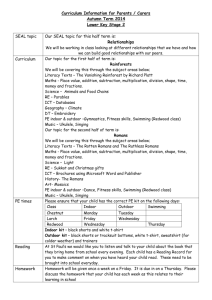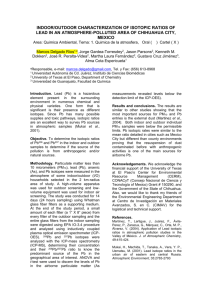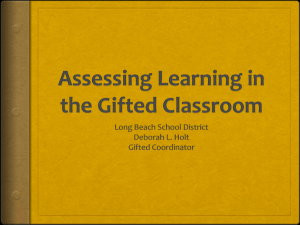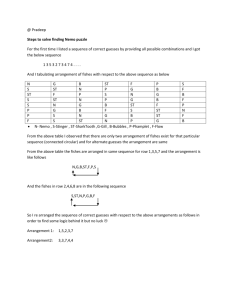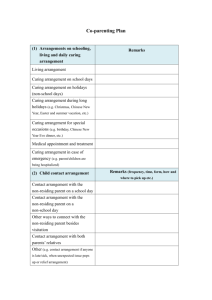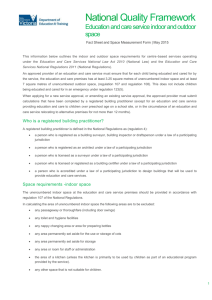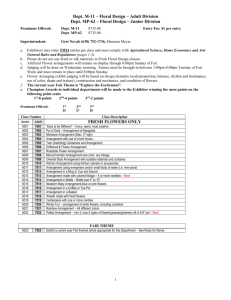Environment as the Third Teacher: Designing Intentional Spaces for
advertisement
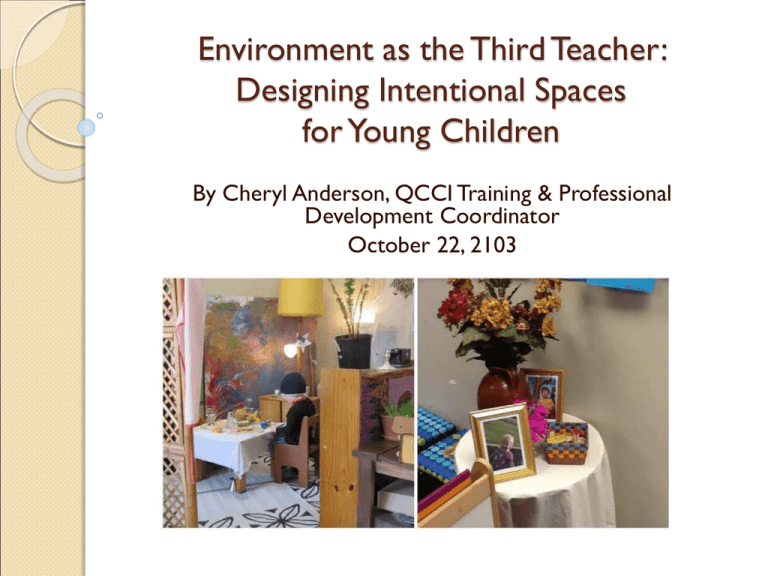
Environment as the Third Teacher: Designing Intentional Spaces for Young Children By Cheryl Anderson, QCCI Training & Professional Development Coordinator October 22, 2103 What is the environment? Indoor and outdoor space Physical design of equipment, furnishings, and materials Daily schedule Why is the environment important to children, staff and families? “Our environments have a great influence on how we feel and how we behave.” Margie Carter and Deb Curtis This is your second home (consider the elements within your own home that offer you comfort, security and a sense of belonging) Offers children the opportunity for choices, exploration, relaxation, investigation & discovery Engages families by creating connections Reflects our beliefs about children and what they deserve Supports their development, interactions, and their interests WHAT MEMORIES DO WE WANT OUR CHILDREN TO HAVE OF THIS SPACE? What is the role of the Early Childhood Educator? To be intentional in the design of the environment both inside and outside To reflect the children, staff and families in the design of the environment To supply materials and activities that reflect the strengths/needs and interests of the children and deepen their explorations To provide children with relevant, real, hands-on materials To provide long uninterrupted periods of time for children to explore their environment To be playful! What elements contribute to a well-designed & inviting environment? Room arrangement Storage & arrangement of materials Aesthetics Natural elements Authentic materials Honoring children’s lives & experiences Indoor and outdoor space consideration Room Arrangement Room Arrangement Provide variety of learning areas When placing learning areas, consider their function and their mood – consider how to define space Be aware of space needs for different learning areas – is there enough room for children to engage with materials? Provide enough materials for each area (need enough materials to have deep exploration for group of children) Be aware of how children flow through areas – do pathways/walkways interfere with children’s play? Be aware of possible barriers to play (create an inclusive play environment for all!) Is the lighting appropriate for the space? Rules around space (can materials be moved from area to area to extend play? Storage and Arrangement of Materials Storage and Arrangement of Materials What materials do we provide? Open-ended versus close-ended? Loose parts? Representational materials? How often do we rotate them? How do we make materials available to children? Do we organize our shelves with a place for all materials – children lose interest in their space when it is overwhelmed with items placed without purpose Create a system for children to retrieve and return objects (use containers that are transparent or made of natural materials and identified by word, picture, object or combination) Do we present materials by creating invitations? Invitations are a collection of interesting and carefully combined materials aesthetically presented. These invitations may be used to: . Respond to/enhance an emerging interest . Introduce children to a new concept . Help children learn new skills Aesthetics Aesthetics Consider the elements of light , sound, “visual clutter”, texture, and colour Implement a variety of lighting sources (floor lamps, table lamps, light table, overhead projector, chandeliers, lights with dimmers, flashlights, prisms or glass balls at windows) Sound – be aware of how sound can affect children – create various listening experiences “Visual clutter” – what do we have on our walls? Be intentional with displays. Texture – need to provide children with different textures (infuse recycled textures) Colour – can be powerful in both positive and negative ways Use neutral colours on walls and add accent colours with decorative elements (pillows, rugs, children’s artwork, curtains, materials) Natural Elements Natural Elements Your space should be filled with natural or living things – what things? Learning tool + they enhance space with beauty Lose the plastic – plastic gives off 35X more energy than wood Children need concrete, real objects (real nature not plastic) Natural elements can be used in play EXERCISE: Photo Study Look at the photos provided and share how natural elements or loose parts are being used in children’s play. Authentic Materials Authentic Materials 1. 2. 3. Term “authentic” refers to an object that is commonly seen or used in an adult space Allows children’s play experiences to mirror real life What authentic materials could be added to each of the following learning centres? Dramatic Play Block Area Science Area Honouring Children’s Lives & Experiences Honouring Children’s Lives and Experiences How do we personalize the space for children? How do we make it theirs? How do we make connections between home and child care? How do we recognize the uniqueness of our children and families? What is the image of the learner conveyed by the materials/things displayed? Are the children’s ideas, work & words honoured by displays? Do commercial materials contribute to children’s learning? Indoor and Outdoor Space Indoor and Outdoor Space Should be an extension of each other Materials and activities can be the same Groups to engage in Photo Study and ask yourselves: 1. What engages me as I look at the photos? 2. What elements could I add to my existing space?
